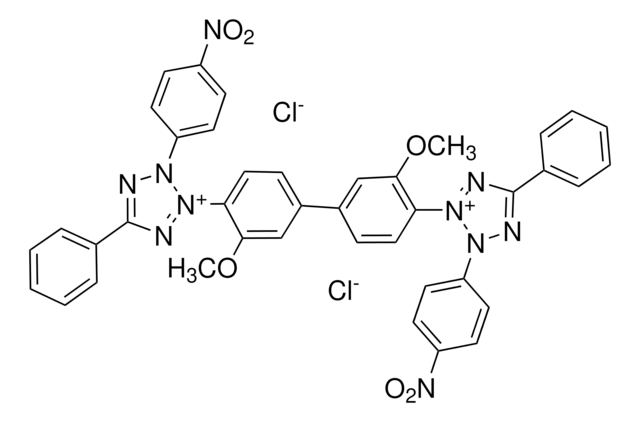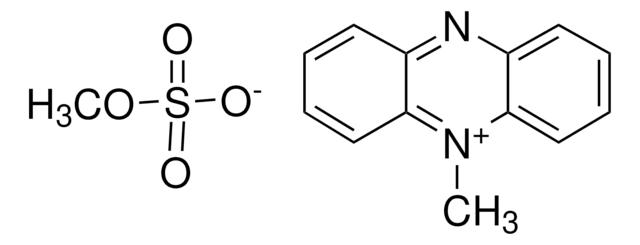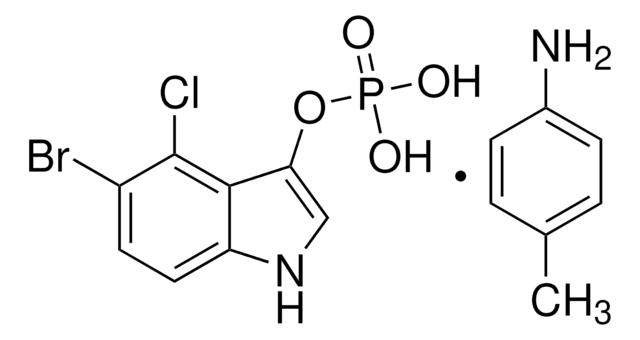93862
Nitrotetrazolium-Blauchlorid
90.0-110.0% (calc. on dry substance, T), powder
Synonym(e):
2,2′-Bis-(4-nitrophenyl)-5,5′-diphenyl-3,3′-(3,3′-dimethoxy-4,4′-diphenylen)-ditetrazoliumchlorid, 3,3′-(3,3′-Dimethoxy-4,4′-biphenylen)-bis-[2-(4-nitrophenyl)-5-phenyl-2H-tetrazoliumchlorid], p-Nitroblau-Tetrazoliumchlorid, p-Nitrotetrazoliumblau, NBT, Nitro BT
About This Item
Empfohlene Produkte
product name
Nitrotetrazolium-Blauchlorid, 90.0-110.0% (calc. on dry substance, T)
Qualitätsniveau
Assay
90.0-110.0% (calc. on dry substance, T)
Form
powder
Verunreinigungen
≤10% solvent content
≤10% water
λ
in methanol
UV-Absorption
λ: 252-262 nm Amax
Lagertemp.
2-8°C
SMILES String
[Cl-].[Cl-].COc1cc(ccc1-[n+]2nc(nn2-c3ccc(cc3)[N+]([O-])=O)-c4ccccc4)-c5ccc(c(OC)c5)-[n+]6nc(nn6-c7ccc(cc7)[N+]([O-])=O)-c8ccccc8
InChI
1S/C40H30N10O6.2ClH/c1-55-37-25-29(13-23-35(37)47-43-39(27-9-5-3-6-10-27)41-45(47)31-15-19-33(20-16-31)49(51)52)30-14-24-36(38(26-30)56-2)48-44-40(28-11-7-4-8-12-28)42-46(48)32-17-21-34(22-18-32)50(53)54;;/h3-26H,1-2H3;2*1H/q+2;;/p-2
InChIKey
FSVCQIDHPKZJSO-UHFFFAOYSA-L
Suchen Sie nach ähnlichen Produkten? Aufrufen Leitfaden zum Produktvergleich
Biochem./physiol. Wirkung
Hinweis zur Analyse
250 mg in 5 mL methanol: yellow to very dark yellow and light brown-yellow to very dark brown-yellow
Signalwort
Warning
H-Sätze
Gefahreneinstufungen
Acute Tox. 4 Oral - Eye Irrit. 2 - Skin Irrit. 2 - STOT SE 3
Zielorgane
Respiratory system
Lagerklassenschlüssel
11 - Combustible Solids
WGK
WGK 3
Flammpunkt (°F)
Not applicable
Flammpunkt (°C)
Not applicable
Analysenzertifikate (COA)
Suchen Sie nach Analysenzertifikate (COA), indem Sie die Lot-/Chargennummer des Produkts eingeben. Lot- und Chargennummern sind auf dem Produktetikett hinter den Wörtern ‘Lot’ oder ‘Batch’ (Lot oder Charge) zu finden.
Besitzen Sie dieses Produkt bereits?
In der Dokumentenbibliothek finden Sie die Dokumentation zu den Produkten, die Sie kürzlich erworben haben.
Kunden haben sich ebenfalls angesehen
Unser Team von Wissenschaftlern verfügt über Erfahrung in allen Forschungsbereichen einschließlich Life Science, Materialwissenschaften, chemischer Synthese, Chromatographie, Analytik und vielen mehr..
Setzen Sie sich mit dem technischen Dienst in Verbindung.







